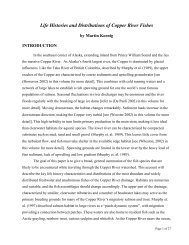Mitigation for the Construction and Operation of Libby Dam
Mitigation for the Construction and Operation of Libby Dam
Mitigation for the Construction and Operation of Libby Dam
You also want an ePaper? Increase the reach of your titles
YUMPU automatically turns print PDFs into web optimized ePapers that Google loves.
<strong>and</strong> reduced again to 28 ganged floating <strong>and</strong> 28 single sinking nets in 1991-1999. Ef<strong>for</strong>t was<br />
fur<strong>the</strong>r reduced from 2000 to present to 14 ganged nets. Fur<strong>the</strong>rmore, netting ef<strong>for</strong>t occurred in<br />
<strong>the</strong> spring <strong>and</strong> fall, ra<strong>the</strong>r than <strong>the</strong> year round ef<strong>for</strong>t prior to 1988. Only fish exhibiting<br />
morphometric characteristics <strong>of</strong> pure cutthroat (scale size, presence <strong>of</strong> basibranchial teeth,<br />
spotting pattern <strong>and</strong> presence <strong>of</strong> a red slash on each side <strong>of</strong> <strong>the</strong> jaw along <strong>the</strong> dentary) were<br />
identified as westslope cutthroat trout; all o<strong>the</strong>rs were identified as rainbow trout (Leary et al.<br />
1983). Kamloops (Gerrard <strong>and</strong> Duncan strain) rainbow trout were distinguished from wild<br />
rainbow trout by eroded fins (pectoral, dorsal <strong>and</strong> caudal); <strong>the</strong>se fish are held in <strong>the</strong> hatchery<br />
until release into <strong>the</strong> reservoir at age 1+. These fish are also marked (tetracycline) prior to<br />
release into <strong>the</strong> reservoir that allows post-mortem age <strong>and</strong> origin determination.<br />
Species abbreviations used throughout this report are: rainbow trout (RB), Kamloops<br />
rainbow trout (KAM), westslope cutthroat trout (WCT), rainbow X cutthroat hybrids (HB), bull<br />
trout (BT), kokanee salmon (KOK), mountain whitefish (MWF), burbot (LING), peamouth<br />
chub (CRC), nor<strong>the</strong>rn pikeminnow (NPM), redside shiner (RSS), largescale sucker (CSU),<br />
longnose sucker (FSU), <strong>and</strong> yellow perch (YP).<br />
The year was stratified into two gillnetting seasons based on reservoir operation <strong>and</strong><br />
surface water temperature criteria:<br />
1) Spring (April - June): The reservoir was being refilled, surface water temperatures<br />
increased to 9 - 13 o C.<br />
2) Fall (September - October): Drafting <strong>of</strong> <strong>the</strong> reservoir began, surface water<br />
temperature decreased to 13 - 17 o C.<br />
Seasonal <strong>and</strong> annual changes in fish abundance within <strong>the</strong> nearshore zone were<br />
assessed using floating <strong>and</strong> sinking horizontal gillnets. These nets were 38.1 m long <strong>and</strong> 1.8 m<br />
deep <strong>and</strong> consisted <strong>of</strong> five equal panels <strong>of</strong> 19-, 25-, 32-, 38-, <strong>and</strong> 51-mm mesh.<br />
Fourteen to twenty-eight floating (ganged) <strong>and</strong> one or two single, sinking nets were set<br />
in <strong>the</strong> fall in <strong>the</strong> Tenmile, Rex<strong>for</strong>d <strong>and</strong> Canada portions <strong>of</strong> <strong>the</strong> reservoir. Spring netting series<br />
consisted <strong>of</strong> 20 to 111 (st<strong>and</strong>ardized to 28 in 1991) sinking nets <strong>and</strong> an occasional floating net<br />
set only in <strong>the</strong> Rex<strong>for</strong>d area. Spring floating <strong>and</strong> fall sinking net data are not included in this<br />
report due to a lack <strong>of</strong> st<strong>and</strong>ardization in net placement. Nets were set perpendicular from <strong>the</strong><br />
shoreline in <strong>the</strong> afternoon <strong>and</strong> were retrieved be<strong>for</strong>e noon <strong>the</strong> following day. All fish were<br />
removed from <strong>the</strong> nets <strong>and</strong> identified, followed by collection <strong>of</strong> length, weight, sex <strong>and</strong><br />
maturity data. Scales <strong>and</strong> a limited number <strong>of</strong> otoliths were collected <strong>for</strong> age <strong>and</strong> growth<br />
analysis. When large gamefish (Kamloops rainbow, cutthroat, bull trout or burbot) were<br />
captured alive, only a length was recorded prior to release.<br />
50
















